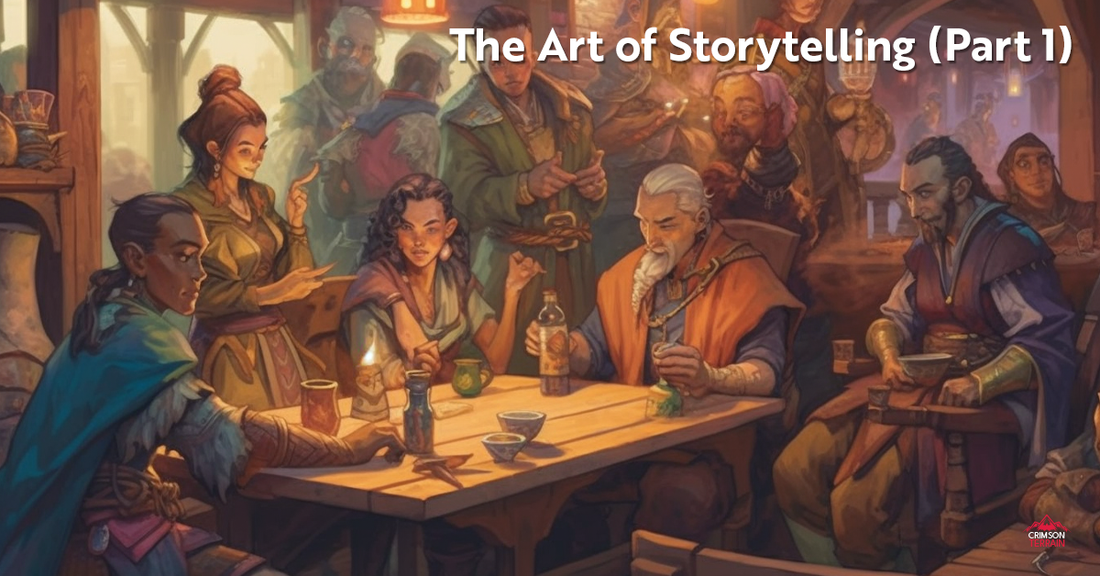In the world of Dungeons & Dragons, storytelling plays an essential role in shaping the experiences of both players and Dungeon Masters alike. A captivating narrative not only breathes life into the game world but also provides a sense of purpose and immersion for the players. With a well-crafted story, adventurers become emotionally invested in their characters, forging connections that can last for years and create unforgettable memories.
The purpose of this multi-part blog post series is to provide guidance and inspiration for Dungeon Masters seeking to elevate their storytelling skills. By sharing tips, techniques, and examples, we aim to help you weave compelling narratives that will captivate your players and keep them coming back for more. As there is so much to cover, we've decided to break it down into multiple posts, delving deeper into each aspect of storytelling in D&D.
Whether you're a seasoned Dungeon Master or new to the role, these insights will help you create engaging, immersive, and memorable D&D campaigns for your players to enjoy. Stay tuned for the upcoming posts in this series as we explore the art of storytelling in the world of Dungeons & Dragons.

Start with a strong hook
An engaging opening scene or event sets the tone for your entire D&D campaign and serves as a crucial first step in capturing your players' attention. A well-crafted hook instantly immerses players into the story, piquing their curiosity and motivating them to dive deeper into the unfolding narrative. It also provides a sense of direction and purpose, giving players a clear objective to pursue or an intriguing mystery to unravel.
Here are some examples of hooks that can instantly draw players into the story:
-
A mysterious stranger: As the adventurers gather in a local tavern, a cloaked figure approaches them with a secretive mission. The stranger shares a cryptic message or a valuable item, hinting at a larger plot that the players must uncover.
-
A call to action: The players' hometown is suddenly besieged by an unknown enemy, forcing them to step up and defend their community. This event unites the characters and sets them on a path to discover the true motivations behind the attack.
-
A dramatic discovery: The adventurers stumble upon an ancient artifact, a hidden dungeon entrance, or a long-lost map that hints at untold treasures and powerful secrets. This discovery propels the players into a grand adventure as they seek to uncover the truth behind their find.
-
A personal connection: One of the player characters receives a letter from a family member, friend, or mentor, pleading for their help in a dire situation. This hook creates an immediate emotional connection and motivates the players to come to the aid of their loved one.
-
A prophecy revealed: The players learn of a prophecy that foretells a great calamity, and they are the key to preventing it. As the chosen ones, they must embark on a quest to gather knowledge, allies, and resources to avert the impending disaster.
Remember, the key to a strong hook is creating immediate intrigue and excitement while providing a clear direction for the players to follow. Tailor your hook to your players' interests and preferences, and they'll be eager to embark on the adventure you've set before them.

Build a detailed world
World-building is a crucial aspect of crafting a compelling D&D campaign, as it lays the foundation for immersion and emotional investment. A well-designed setting not only provides a vivid backdrop for the players' adventures but also helps to establish the tone, themes, and cultural context of the story. By creating a rich and believable world, you give your players a place they'll want to explore, engage with, and ultimately care about.
Here are some tips for creating a rich, believable setting:
-
Develop a history: Every world has a past. Creating a timeline of key historical events, such as wars, discoveries, and the rise and fall of empires, adds depth and complexity to your setting. This history can also provide inspiration for adventures and story hooks.
-
Create diverse cultures and societies: Populate your world with a variety of races, cultures, and societies, each with their own customs, beliefs, and values. This diversity makes your setting feel more authentic and offers opportunities for interesting role-playing experiences and conflicts.
-
Design unique landmarks and locations: From towering mountains and sprawling cities to enchanted forests and hidden dungeons, memorable locations make your world feel alive and distinct. Consider the natural and architectural features that define each area, as well as any legends or stories associated with them.
-
Establish a system of politics and power: Consider the relationships between various factions, nations, and organizations within your world. These dynamics can generate intrigue, alliances, and rivalries that influence the unfolding story.
-
Develop a pantheon of deities: The presence of gods and religious institutions can add another layer of complexity to your world. Determine which gods hold power, their domains, and how they interact with mortals and each other.
To incorporate world lore into the campaign story, consider the following:
-
Integrate historical events into the main narrative: Use the history of your world as a backdrop for the story, referencing past events that have a bearing on the current situation or foreshadow future developments.
-
Encourage player characters to explore their own cultural backgrounds: Tie each character's backstory to the world's lore, encouraging them to engage with their heritage and personal history throughout the campaign.
-
Feature NPCs that embody the setting's culture and history: Use NPCs as a means of conveying the world's lore to the players, sharing tales, legends, and insights that enrich the narrative and deepen their understanding of the setting.
-
Embed lore within adventures and quests: Incorporate elements of your world's history and culture into the challenges and objectives that players face, ensuring that the lore is integral to the unfolding story.
By building a detailed world and seamlessly weaving its lore into the campaign narrative, you create a captivating and immersive experience that will leave your players eager to explore every corner of your creation.

Create meaningful choices and consequences
Player agency is a critical aspect of D&D storytelling, as it empowers players to shape the narrative through their characters' actions and decisions. By offering meaningful choices with tangible consequences, you create a dynamic and engaging story that evolves based on the players' input. This sense of autonomy not only enhances immersion but also fosters a deeper emotional investment in the story's outcome.
Here are some tips for crafting decisions with meaningful consequences:
-
Offer multiple paths: Provide players with different options for achieving their goals, each with its own set of challenges, risks, and rewards. This approach encourages creativity and strategic thinking, as players weigh the potential consequences of each choice.
-
Ensure consequences are logical and consistent: The outcomes of players' decisions should feel natural and grounded in the context of the world and story. This consistency helps to maintain immersion and reinforces the idea that players' actions have a genuine impact on the narrative.
-
Create moral dilemmas: Present players with situations that challenge their values and beliefs, forcing them to make difficult choices that reveal their characters' true nature. These moral quandaries can lead to powerful moments of introspection and character development.
-
Allow for long-term consequences: The effects of players' choices should extend beyond the immediate situation, shaping the course of the campaign and potentially altering the world around them. This approach underscores the significance of their decisions and encourages players to think carefully about their actions.
Balancing player freedom with narrative structure can be challenging but is essential for maintaining a cohesive and engaging story. Consider the following strategies:
-
Use a modular story structure: Design your campaign as a series of interconnected story arcs, each with its own self-contained plot and objectives. This approach allows players to explore the world and make choices within each arc while still maintaining an overarching narrative.
-
Adapt to player decisions: Be prepared to adjust your storyline and planned events based on the choices players make. By remaining flexible and responsive, you can ensure that the narrative remains dynamic and engaging, even when players take unexpected paths.
-
Set clear goals and boundaries: While it's important to offer players freedom, it's also necessary to establish a framework for the story. Set clear objectives and guidelines for the campaign, providing a sense of direction without dictating every detail of the players' actions.
-
Encourage collaboration and communication: Foster open communication between you and your players, allowing them to express their intentions and ideas for the story. By working together, you can create a narrative that balances player agency with a cohesive structure.
By offering meaningful choices and consequences, and balancing player freedom with narrative structure, you'll create a dynamic and engaging D&D experience that keeps your players invested and immersed in the unfolding story.
Don't miss the next installment
In this first installment of our multi-part series on crafting compelling narratives in D&D campaigns, we've explored the importance of starting with a strong hook, building a detailed world, and creating meaningful choices and consequences. We hope you've found these insights valuable in shaping your own storytelling techniques as a Dungeon Master. Be sure to look for the next part of our series next week, where we'll dive deeper into more aspects of creating engaging and immersive D&D campaigns. Happy adventuring!

